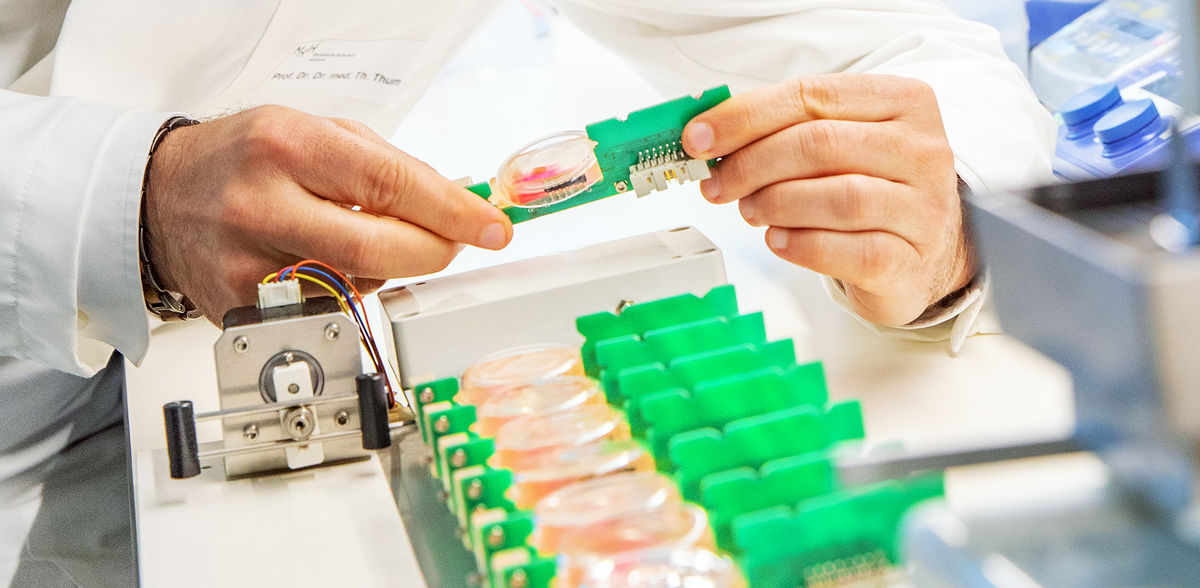Living heart muscle slices drive RNA research into heart failure
Researchers place living human heart tissue in a nutrient solution and use it to test new drugs and innovative approaches to combat heart failure
microRNAs (miRNAs) are also involved in the development of diseases. These small RNA snippets belong to the so-called non-coding RNAs: although they do not contain any genetic information for the production of a protein, they fulfil an important task in the control of fundamental biological processes in our cells. They therefore offer a new starting point for therapies. Professor Dr Dr Thomas Thum, Head of the Institute of Molecular and Translational Therapy Strategies at Hannover Medical School (MHH), has been researching miRNAs for years, which regulate inflammatory and fibrotic genes that trigger stiffening of the heart muscle tissue (cardiac fibrosis) and thus also heart failure. In earlier studies on cell cultures and in the mouse model, he was already able to show that inhibiting the microRNA miR-21 has a positive effect on the development of fibrosis and could therefore improve heart function.
In a recent study, he and his team have now demonstrated this effect in human heart tissue for the first time. They used the method of "living myocardial slices" (LMS). The material for this comes from the MHH Clinic for Cardiac, Thoracic, Transplantation and Vascular Surgery and is, so to speak, tissue waste from diseased hearts that have been removed as part of a transplant. These heart muscle discs continue to live and beat in nutrient solution for many days to weeks. The results of this new joint study have just been published in the "European Heart Journal".
microRNA blocker ensures fibrosis regression
The transplants were necessary because the hearts could no longer work properly due to cardiac insufficiency - also known as heart failure in medicine. The heart, weakened by a heart attack or high blood pressure, tries to compensate for its reduced pumping capacity by increasing its own volume: The heart grows stronger and stronger and overtaxes itself more and more. This very often leads to a proliferation of connective tissue cells (fibroblasts) in the heart muscle, which increasingly stiffen the heart and lead to fibrosis. "miR-21 plays a decisive role in this development," says Professor Thum. The researchers investigated what happens when the harmful function of miR-21 is switched off. To do this, they used a so-called antisense molecule, which attaches itself precisely to the microRNA as a mirror image structure and can thus block it. "We added the blocker to the cultivation chambers in which our LMS from the explanted, fibrosis-damaged hearts lived on," explains the cardiologist. The researchers were able to observe that the fibrosis in the tissue sections partially regressed. As a result, the tissue became more elastic, the heart muscle cells were able to relax more when beating and their viability increased.
LMS model proves its worth for preclinical proof of efficacy
"To our knowledge, this is the first study in which the effects of miR-21 have been investigated directly on living human heart tissue," says Professor Thum. The LMS model has proven its worth in providing preclinical proof of efficacy and should also contribute to a significant reduction in animal testing in the future. "The tests in the cultivation chambers have shown that the miR-21 blocker is a potential drug candidate for stopping and even reversing fibrosis development in heart failure."
As fibrosis can also affect other organs, the antisense molecule could also be considered for the treatment of liver or lung fibrosis. "In addition, heart failure is often accompanied by concomitant diseases in organs such as the liver and kidneys, so suppressing miR-21 could presumably also have advantages in cases of impaired liver and kidney function," the scientist surmises. The next step for the researchers is to clarify how the blocker can be delivered safely and precisely to the desired target. The researchers are already working on a solution that should make it possible to deliver RNA therapeutics to various organs in a targeted manner in the future.
Original publication
Naisam Abbas, Jonas A Haas, Ke Xiao, Maximilian Fuchs, Annette Just, Andreas Pich, Filippo Perbellini, Christopher Werlein, Fabio Ius, Arjang Ruhparwar, Jan Fiedler, Natalie Weber, Thomas Thum; "Inhibition of miR-21: cardioprotective effects in human failing myocardium ex vivo"; European Heart Journal, 2024-3-5





















































